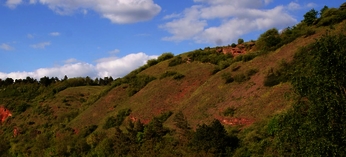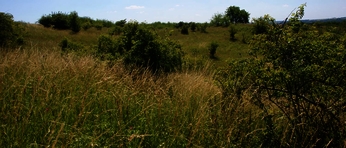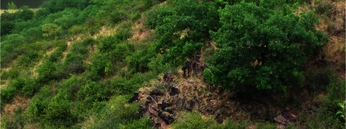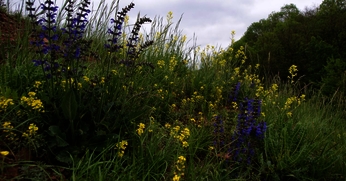Improvement of the conservation status of species-rich open terrestrial habitats on management-depending small fragmented sites and establishment of a conservation-specific success assessment
Background
Background
The majority of endangered open terrestrial habitats of the European Union's Habitats Directive's (92/43/EEC) Annex I are dependent on extensive agricultural land use. Predominantly, this encompasses management-dependent different dry grasslands (e.g. habitat codes 6210(*), 6240*), lowland hay meadows (6510), species-rich humid meadows (6410, 6440) and mountain pastures (6230*, 6520) as well as naturally small-sized sites like inland salt meadows (1340*) or Calaminarian grasslands (6130), which are at least dependent on sporadic management. These habitats are usually very rich in both animal and plant species and often harbour a high percentage of endangered species. A higher land use intensity on the one hand and predominantly lack of use on less productive sites are the main reasons for the endangerment of these species and habitats.
Recently, concepts for larger complexes with open terrestrial habitats have been developed in Saxony-Anhalt, which may ensure their long-term preservation, for example the extensive grazing projects with mega herbivores in the Oranienbaumer Heide and the „Toten Tälern“. Additionally, precursors to this project initiated goat grazing at different sites in the Lower Saale Valley, which will be continued here.
Endangered open terrestrial habitats as well as habitats of rare plant and animal species are currently often rather small-sized.Many of the sites we find today are only relics of former larger occurrences that remain as islands of small, fragmented areas (e.g. dry grassland fragments within shrub encroachment) - basically the last safe-harbours for many specialized species and endangered habitats.
The majority of these small, fragmented sites lies within Natura 2000 areas. Nevertheless, many of them have lain fallow for several decades, but others have been abandoned more recently for socio-economic reasons. A reason for this is that land-use on these sites is often hampered by specific characteristics like unfavourable terrain, high ground water level, isolation or lack of a necessary first instalment.
However, exactly these small, fragmented sites often represent very species-rich remainders of open habitats and are home to populations of rare plant and animal species. We have to urgently find solutions for these, from a conservation standpoint, highly valuable sites with respect to management and financing. Since species diversity in open terrestrial habitats is aggregated in these small areas, the solution of this problem is essential for the conservation of species diversity in Saxony-Anhalt.

Fragmented dry grassland habitats at a steep slope along the river Saale in the Lower Saale Valley. Due to shallow soils, these sites not very productive. Moreover, because of the steep slopes and restricted access, there is a higher management effort. 
Following cessation of management, dry grassland habitats are often dominated by fast-growing, fallow-tolerant grass species (here tall oat-grass, Arrhenatherum elatius). The dense grass canopy and accumulating dead plant mass increasingly supersede dry grassland species with low competitive ability. 
Due to cessation of management, finally shrub encroachment leads to a stepwise degradation of the characteristic species inventory of dry grassland. Partly, these sites show still dry grassland species in open parts even after decades. To preserve these, actions are acutely required now. 
The goal has to be the restauration of open sites low in competition on priority sites. Here you can see a regularly grazed and thus species- and flower-rich dry grassland with the two responsibility species of Saxony-Anhalt: Astragalus exscapus and Scabiosa canescens. Project aims
Project aims
Subproject B
The most important goal of subproject B was to determine a pool of small species-rich fragmentated areas (focus on botanical species protection), initially based on three model regions (districts of Börde, Harz, Wittenberg), on the basis of existing data material and in close cooperation with the regional authorities (State Office for Environmental Protection, Lower Nature Conservation Authorities) and local experts (e.g. Saxony-Anhalt Working Group for Native Orchids, Saxony-Anhalt Botanical Association). In the course of the project work, the pool proposal was extended to all Saxony-Anhalt.
Within the scope of plausibility checks, the area boundaries had to be adjusted, re-mapping of species and LRT occurrences had to be carried out and management difficulties had to be examined.
In addition, subproject B researched recommendations for the maintenance of open habitat and biotope types as well as costs for suitable maintenance measures, developed exemplary profiles for the maintenance of priority areas and initiated and implemented selected maintenance projects on priority areas in the model regions.
Download area
Download area
Practical guide to goat grazing, as of 2019
Projekt leader: Prof. Dr. Sabine Tischew
Researchers: Dr. Daniel Elias, Dr. Alrun Siebenkäs, Thomas Engst, M.Sc., Vera Senße, M.Sc.
Funded by: ELER- Sachsen Anhalt (Funding period: 20.02.2017-30.09.2020).
Landesverwaltungsamt Sachsen-Anhalt








